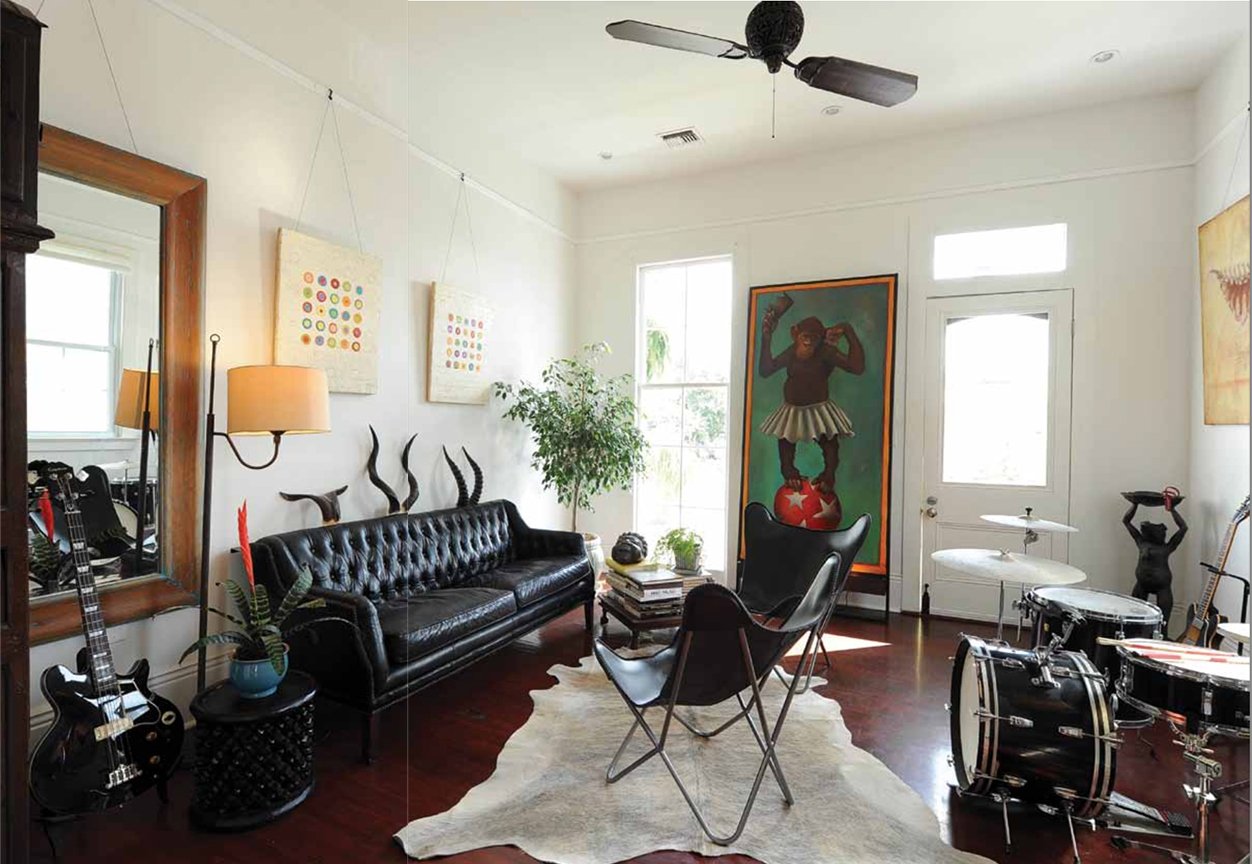One Man’s Coop
New Orleans Magazine
Facing page: Located in a neighborhood known as Pigeon Town, the historic shot- gun sits on a corner lot. Above: Guidry’s painting of a monkey has the feeling of a circus relic and a place of honor by the front door of the living room that doubles as a music studio. Seating is provided with a leather Chesterfield sofa and a pair of butterfly chairs.
It is an example of what makes New Orleans special:: a pristine single shotgun house proudly located on a corner lot in a mixed neighborhood. it faces a commercial building and it is catercorner to a neighborhood bar referred by the neighbors as the “social club.” there, folks gather on the sidewalk in an impromptu fashion to sit on wooden chairs or just stand around.. Here in new orleans, it’s fine to live cheek-to-jowl with a bar and commercial building, as long as you live in an interesting house. it is even better if the shotgun has a chartreuse front door and a robin’s egg blue exterior, also a gingerbread trim on the porch and high ceilings inside.
Meet Michael guidry, a talented artist and owner of the handsome corner house in the west Carrollton neighborhood known as Pigeon town. “this is a great place to live,” he says as he sits in a black leather butterfly chair in his living room. “it is truly eclectic in that we have a little bit of everything here – fine historic houses, decaying houses, commercial buildings, restaurants and neighborhood bars.” smiling, he adds, “Yes, you could call this a funky neighborhood – and i love it.”
He enjoys listing some of the many reasons why he loves his jewel of an historic house: “i feel that it is small enough to manage by myself, yet large enough to feel like i can breathe. i like that there are several hangout places in the house for me to sit and read or do business. i love the two back rooms that i use as my studio, the small yet functional kitchen and the large bedroom. i feel there is energy here, and i enjoy using the whole house every day.”
This page, top: The master bedroom is flooded with light from the large win- dows and open doorway. Guidry’s art hangs in the room. Left: Guidry’s red bike is kept safely in his dining room. Above: The utilitarian kitchen features a framed Drew Brees clipping from the newspaper. Facing page, left: A col- lection of African artifacts decorates the reading room, with space allotted for a unique wine rack. Facing page, right: Michael Guidry with some of his recent paintings.
guidry has filled his home with meaningful things he has col- lected over the years. in the living room, there is a set of drums, a guitar, a bass and walls filled with his art. the circus monkey is one of his favorites of his own work. it has a place of honor between the window and front door and seems ready to dance a jig on the big ball. and what is that on the ledge behind his leather couch? “it’s a collection of interesting animal horns i have collected over the years,” guidry answers. and there is another guitar on the floor and black leather butterfly chairs that remind him of the ones that were in his home when he was a child.
“My living room is special because it is where lauren, my wife, and i used to play music togeth- er,” he says. “i’m not much of a musician, but she would write songs and teach me the percussion and bass parts.” (lauren, an adjunct music profes- sor at tulane University, passed away last year.)
there is no doubt that guidry surrounds himself with things he loves, so there’s no need to blink when you walk into the dining room and see a bicycle propped up against the window. this is the room with a special comfortable leather chair in the corner just for guidry’s dogs – Mugsy, a Brussels griffon, and andre, a affenpinscher, and it seems appropriate for the cow in his large painting to somehow be watching over his dogs.
the third room of the shotgun configuration is devoted to a collection of african artifacts. “i call it my reading room because it is cozy and a great place to relax and read.” it is also where he displays his wine collection.
guidry says he especially likes his master bedroom because it is filled with light from the large window and glass-paneled door that overlooks the side porch and garden. “i like the access to my side garden from the bedroom,” he says as he walks out onto the porch. “it’s a great spot to enjoy my morning coffee.” to provide more privacy for the side garden, he erected a wooden fence. “it was one of the first things i did after buying the house in 2009.”
He proudly shows off the two back rooms that he uses as a studio. “i enjoy working at home,” he explains. “i used to have my studio at a different location. now i feel so centered having everything right here in my home.”
His home is a quiet haven for him. “i love being a part of such an interesting neighborhood,” he says. “i’ve never walked across the street and joined the talking and laughing in front of the bar, but if i ever get tired of the quiet, i could.”








